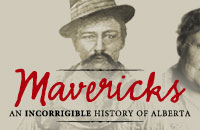|

Mapping Our Way Through History
Conducting an Inquiry Process of Historical Maps Using Journaling
and Questioning Strategies
Introduction
Students need to possess geographic thinking skills that provide
the tools to address social studies issues from a geographical perspective.
They need to be able to use geographic thinking to construct and
interpret various types of maps (i.e. historical, physical, political
maps) to broaden understanding of topics being studied. Why were
maps made in the past? What types of information did they provide
for the users? Were they accurate? What can historical maps tell
us now about Alberta and its people?
Project Explanation
In this project, students will develop an appreciation of the development
of maps as both a science and an art. They will rigorously examine
a historical map using the student process questions provided in
order to gain a deeper understanding of the topics being studied
and to augment geographic thinking skills.
Alberta Social Studies Curriculum Unit Connections
Grade Four - Alberta: The Land, Histories and Stories
4.1 Alberta: A Sense of the Land
4.2 The Stories, Histories and People of Alberta
4.S.3 develop skills of geographic thinking (interpreting historical
maps)
Grade Five - Canada: The Land, Histories and Stories
5.1 Physical Geography of Canada
5.2 Histories and Stories of Ways of Life in Canada
5.S.3 develop skills of geographic thinking (interpreting historical
maps)
Grade Seven
7.S.3 develop skills of geographic thinking (interpreting historical
maps)
Materials and Resources Needed
Procedures
Students will undertake a historical map-based inquiry using the
historical maps on the Mavericks: An Incorrigible History of
Alberta site. The process would be similar to how an actual
historian would approach a study of any historical materials. Students
will examine a primary historical source map using journaling and
questioning strategies.
The teacher may use the written information contained in the Maps
section of the Mavericks: An Incorrigible History of Alberta
site to introduce the unit, as it will provide some background for
the students on the importance of maps in the past.
Students may work individually, in pairs, or in small groups. Each
will choose one of the historical maps to complete an inquiry on.
They will need to gain an accurate and comprehensive understanding
of the background and history of the map, its creator, and its uses
so that they may share their map with the class at the end of the
project.
Students will use the following questions to guide their inquiry,
choosing the ones that are appropriate to their specific historical
map.
Historical Map-Based Learning: Student Process Guide
- Who created the map?
- When was the map created?
- What do we know about the creator from examining the map?
- Was the map created by hand or by machine?
- Do they belong to a specific group, organization, or culture?
- What does it tell us about their group, organization, or culture?
- Why was the map created in the first place? What was its purpose?
- Who would use this map? What would they use it for?
- Is there a scale on the map?
- Is there a legend on the map?
- Are their any symbols, designs, or decorations on the map? What
do they mean?
- Is there a great deal of detail on the map? Would it be helpful
for other people to use if traveling to the area represented?
- What areas does the map represent? Are they represented accurately?
(Compare to a modern map of the area in an atlas)
- Are there any mistakes contained in the map?
- What information is contained on the map about its topic? What
does it tell us about the time in which it was created?
- Are there differences between this map and a modern map of the
same area? Have any borders and boundaries changed?
- What did you learn about that time period from the map?
- Are we able to infer any ideas about how people lived at the
time from the map?
- What does this map tell us about Alberta or Canada and its growth?
- What do you think is the historical significance of this map?
Why is it important to a museum?
- What questions do you still have about the map or its subject?
Once the historical map inquiry is completed, students may create
a large-scale version if time permits to aid in the presentation
of their findings.
Assessment and Evaluation
- Students and their teacher should develop their own rubric by
identifying evaluation criteria for the project that will match
their own learner outcomes. This allows students to understand
the expectations for their work and to have input into the ongoing
evaluation process.
- Individually or in small groups, students might evaluate the
work of two or three other students in order to gain insight into
how their peers approached the project.
- After completing the project, students may talk or journal about
what they felt they did very positively, what they had difficulty
with, and how they would change how they would approach a similar
project in the future.
Ideas for Enriching this Project
- Students may make a comparison of two different historical maps
and examine how their purposes and information are different.
- Students may create their own historical or personal maps using
a variety of methods. They can choose a topic, making sure they
label all pertinent information that they include.
- Using ICT, they can draw it using grid lines in Word or Kidpix
of their school or community
- They can create their own version of a historical map. It
could be based the map they studied or on the travels of one
of the Mavericks, including any locations where important events
took place. They could even attempt to make it look old and
worn.
- They can create a map of the future. What will Alberta look
like in 2105?
 |



![]()
